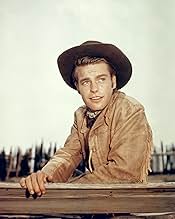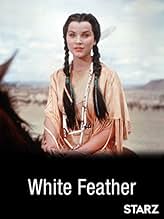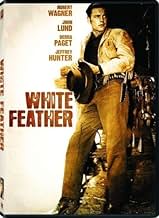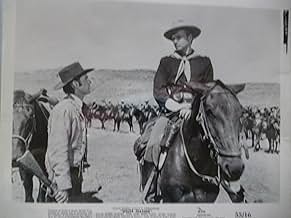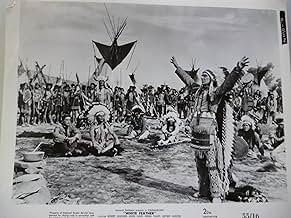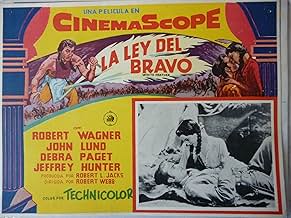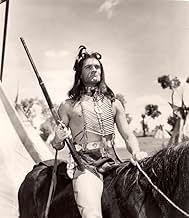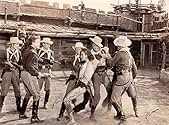CALIFICACIÓN DE IMDb
6.4/10
1.3 k
TU CALIFICACIÓN
Agrega una trama en tu idiomaIn 1877 Wyoming, during the peace negotiations between the Cheyenne and the USA, an Indian girl falls in love with a land surveyor, causing the ire of her Cheyenne fiance.In 1877 Wyoming, during the peace negotiations between the Cheyenne and the USA, an Indian girl falls in love with a land surveyor, causing the ire of her Cheyenne fiance.In 1877 Wyoming, during the peace negotiations between the Cheyenne and the USA, an Indian girl falls in love with a land surveyor, causing the ire of her Cheyenne fiance.
- Dirección
- Guionistas
- Elenco
Noah Beery Jr.
- Lt. Ferguson
- (as Noah Beery)
Iron Eyes Cody
- Indian Chief
- (sin créditos)
- Dirección
- Guionistas
- Todo el elenco y el equipo
- Producción, taquilla y más en IMDbPro
Opiniones destacadas
The film is a respectful telling of the 1877 campaign in Wyoming to contain the Indians by persuading them to leave the plains, sign the treaty of peace, and move to a new land in the south
Wagner who affirms to colonel John Lund in charge of Fort Laramie that he has no feeling about Indians, makes Indians friends, particularly with two young warriors Little Dog and American Horse...
Complications arise when Chief Broken Hand's daughter Appearing Day (Debra Paget) engaged to American Horse falls in love with Tanner (Wagner) and he with her Tanner's friendship with Little Dog grows slowly but surely It is one of the most enduring traits of the film, having just the right amount of momentum, frustration and humor...
Jeffrey Hunter steals the show with a great performance of the proud warrior Little Dog whose pen does not fit Cheyenne warriors' hand as well as the arrow Little Dog's blood ran hot at the council, gets angry and chooseswith his pal American Horse to meet the troops in battle
Eduard Franz is superb as the venerable Indian chief, Broken Hand, who called the council to tell them that on this day, they have agreed to take the offer of the white man and leave this country Hugh O'Brian is well chosen as Hunter's best friend, American Horse Noah Beery does one of his better work as the obedient cavalry lieutenant
Debra Paget reprises her role as the radiant Indian girl Appearing Day who would be happy in a white man's world We all remember her role as the delicate Indian healer girl Sonseeahray in Delmer Daves' memorable Western "Broken Arrow."
Robert D. Webb captures splendid panoramic shots that site expansive stretches of green fields and blue skies Webb does provide a handful of transcendent moments, the most spellbinding of which is Tanner's participation in honoring his brave friend
Wagner who affirms to colonel John Lund in charge of Fort Laramie that he has no feeling about Indians, makes Indians friends, particularly with two young warriors Little Dog and American Horse...
Complications arise when Chief Broken Hand's daughter Appearing Day (Debra Paget) engaged to American Horse falls in love with Tanner (Wagner) and he with her Tanner's friendship with Little Dog grows slowly but surely It is one of the most enduring traits of the film, having just the right amount of momentum, frustration and humor...
Jeffrey Hunter steals the show with a great performance of the proud warrior Little Dog whose pen does not fit Cheyenne warriors' hand as well as the arrow Little Dog's blood ran hot at the council, gets angry and chooseswith his pal American Horse to meet the troops in battle
Eduard Franz is superb as the venerable Indian chief, Broken Hand, who called the council to tell them that on this day, they have agreed to take the offer of the white man and leave this country Hugh O'Brian is well chosen as Hunter's best friend, American Horse Noah Beery does one of his better work as the obedient cavalry lieutenant
Debra Paget reprises her role as the radiant Indian girl Appearing Day who would be happy in a white man's world We all remember her role as the delicate Indian healer girl Sonseeahray in Delmer Daves' memorable Western "Broken Arrow."
Robert D. Webb captures splendid panoramic shots that site expansive stretches of green fields and blue skies Webb does provide a handful of transcendent moments, the most spellbinding of which is Tanner's participation in honoring his brave friend
Looked at this on TV as just another western but found myself admiring the camera-work, scenery and performances. Though the direction was at times unexciting, the story was well told and dignified by a good performance by Wagner, so very handsome that it is no wonder the young squaw wants her first kiss with him. Jeffery Hunter, so overlooked but always worth watching, looking incredibly fit (sad to think he died just 4 years later) gave a very strong performance as the head-strong son of the chief, (reminds me of Sal Mineo in Cheyenne Autumn (same story?)) who rides around with Hugh O Brian (Wyatt Earp as an native American!). at the end the scenes between Wagner and Hunter are poignant and stay with you. The sad face of the chief says it all. The film was just a bit overlong and drags in parts which meant I missed bits that I should not have done, but there are some magnificent scenery and cavalry and Indian charges.
The production company sure got its money's worth by filming in Durango, Mexico. Those scenes of mass Indian migration, along with the massed warriors and cavalry troop of the climax are impressive as heck. I expect a lot of Mexican folks picked up a payday as a result. In fact, where this western really succeeds is in providing spectacle. The fort scenes plus the Indian encampments are both big and convincing.
The storyline may not be exactly fresh—some Indians wanting to make peace while others don't, plus the standard romantic interest—nonetheless, the individual stories are woven well into the larger conflict. Note too, how the screenplay (based on a true story) takes a generally sympathetic view of the Indians' plight— that is, being forced to move by treaty from their traditional lands. This was during a period when Hollywood was beginning to recognize Indians as human beings instead of convenient targets for repeating rifles.
Of course, an A-production requires a guaranteed box-office, and who better to bring in young folks than a leading heartthrob of the day, Robert Wagner. His rail thin frame may not look like John Wayne, but he still manages to convey the needed authority despite his pretty boy appearance. Also, Hunter remains physically impressive as the conflicted Little Dog.
I guess my only gripe is that everyone, Indians included, looks like they just stepped out of a fashion magazine. I mean the costumes are so squeaky clean and perfectly fit that you'd never guess this is supposed to be the dusty frontier. Anyway, this TCF release remains an underrated cowboy-Indian flick, especially for all its impressive crowd scenes.
(In passing—good touch allowing ambient noises such as barking dogs, squawking birds, and crying kids, to color the treaty signing scene. Usually, Hollywood would remove these as distractions, but here they lend a noisy realistic touch.)
The storyline may not be exactly fresh—some Indians wanting to make peace while others don't, plus the standard romantic interest—nonetheless, the individual stories are woven well into the larger conflict. Note too, how the screenplay (based on a true story) takes a generally sympathetic view of the Indians' plight— that is, being forced to move by treaty from their traditional lands. This was during a period when Hollywood was beginning to recognize Indians as human beings instead of convenient targets for repeating rifles.
Of course, an A-production requires a guaranteed box-office, and who better to bring in young folks than a leading heartthrob of the day, Robert Wagner. His rail thin frame may not look like John Wayne, but he still manages to convey the needed authority despite his pretty boy appearance. Also, Hunter remains physically impressive as the conflicted Little Dog.
I guess my only gripe is that everyone, Indians included, looks like they just stepped out of a fashion magazine. I mean the costumes are so squeaky clean and perfectly fit that you'd never guess this is supposed to be the dusty frontier. Anyway, this TCF release remains an underrated cowboy-Indian flick, especially for all its impressive crowd scenes.
(In passing—good touch allowing ambient noises such as barking dogs, squawking birds, and crying kids, to color the treaty signing scene. Usually, Hollywood would remove these as distractions, but here they lend a noisy realistic touch.)
As a "Western movie" buff, I am surprised that this film is not more familiar to aficionados of the genre. It is a near epic, classical film.
Of course, it suffers from the usual defect common to Westerns made in this era: The Native American leads are played by white actors and there isn't adequate time to fully develop all of the characters.
Still, it is a magnificent film. It has elements of Shane, which was made several years before, and of The Searchers, which was made a year after.
The sweep and the grandeur are very reminiscent of John Ford films. No expense was spared in cinematography, locations, and the number of extras that were employed. Hundreds of Native Americans were employed, including women and children of all ages. The number of mounted cavalry approximate the size of a cavalry regiment. There weren't that many mounted soldiers in John Ford's cavalry trilogy. And, it was all achieved without the aid of computer graphics.
The dialog is realistic and the story, itself, is based on a true incident. A young Robert Wagner is very believable and likable in his solid, understated role.
This film is enormously enjoyable. I remember seeing it in the 1950s at a drive-in theater, and if only I could do so again!
Of course, it suffers from the usual defect common to Westerns made in this era: The Native American leads are played by white actors and there isn't adequate time to fully develop all of the characters.
Still, it is a magnificent film. It has elements of Shane, which was made several years before, and of The Searchers, which was made a year after.
The sweep and the grandeur are very reminiscent of John Ford films. No expense was spared in cinematography, locations, and the number of extras that were employed. Hundreds of Native Americans were employed, including women and children of all ages. The number of mounted cavalry approximate the size of a cavalry regiment. There weren't that many mounted soldiers in John Ford's cavalry trilogy. And, it was all achieved without the aid of computer graphics.
The dialog is realistic and the story, itself, is based on a true incident. A young Robert Wagner is very believable and likable in his solid, understated role.
This film is enormously enjoyable. I remember seeing it in the 1950s at a drive-in theater, and if only I could do so again!
White Feather is a combination of the plots of both Broken Arrow and Cheyenne Autumn. It's the story of a romance between Robert Wagner and Indian princess Debra Paget set against the background of the surrender of the Cheyenne nation to the white man.
Wagner is part of delegation sent to the Cheyenne chief Eduard Franz to negotiate a treaty with the Cheyenne. Although Franz's son Jeffrey Hunter is for no surrender at any price, he and Wagner become friends. Wagner becomes more than friends with Hunter's sister Paget, something that arouses the old jealous green eye in Hugh O'Brian, an Cheyenne warrior who figures Paget's his.
Paget's not going to find it easy in the white world in any case. The post sutler Emile Meyer's not liking Indians in any case and even though his daughter Virginia Leith becomes friends with Paget, she's got a thing for Wagner herself.
White Feather is a sympathetic portrayal of the Cheyenne in the last days of a proud warrior nation. Best in the cast is Jeffrey Hunter, the man who won't give in and most of all won't surrender his pride.
John Lund as the post commander and Milburn Stone the civilian treaty negotiator are in the cast as well. White Feather is a fine western that does not get near enough acclaim.
Wagner is part of delegation sent to the Cheyenne chief Eduard Franz to negotiate a treaty with the Cheyenne. Although Franz's son Jeffrey Hunter is for no surrender at any price, he and Wagner become friends. Wagner becomes more than friends with Hunter's sister Paget, something that arouses the old jealous green eye in Hugh O'Brian, an Cheyenne warrior who figures Paget's his.
Paget's not going to find it easy in the white world in any case. The post sutler Emile Meyer's not liking Indians in any case and even though his daughter Virginia Leith becomes friends with Paget, she's got a thing for Wagner herself.
White Feather is a sympathetic portrayal of the Cheyenne in the last days of a proud warrior nation. Best in the cast is Jeffrey Hunter, the man who won't give in and most of all won't surrender his pride.
John Lund as the post commander and Milburn Stone the civilian treaty negotiator are in the cast as well. White Feather is a fine western that does not get near enough acclaim.
¿Sabías que…?
- TriviaFirst American movie filmed (in 1954) in Durango, Mexico, because art director Jack Martin Smith liked the soundstages in the city and found the surrounding landscapes to be just what he was looking for.
- ErroresThe Army, at no time during the Indian Wars, used Winchester repeating lever action rifles, as shown.
- Citas
Josh Tanner: Eveything you will see in this movie actually happened, with the exception being the Indians' language. For the purposes of this story, they will speak English so that you can understand them.
- ConexionesReferenced in Chappaqua (1966)
Selecciones populares
Inicia sesión para calificar y agrega a la lista de videos para obtener recomendaciones personalizadas
- How long is White Feather?Con tecnología de Alexa
Detalles
- Fecha de lanzamiento
- País de origen
- Idioma
- También se conoce como
- White Feather
- Locaciones de filmación
- Fort Laramie National Historic Site - 965 Gray Rocks Road, Fort Laramie, Wyoming, Estados Unidos(actual Fort at center of events and activities portrayed)
- Productora
- Ver más créditos de la compañía en IMDbPro
Taquilla
- Presupuesto
- USD 1,125,000 (estimado)
- Tiempo de ejecución1 hora 42 minutos
- Relación de aspecto
- 2.55 : 1
Contribuir a esta página
Sugiere una edición o agrega el contenido que falta

